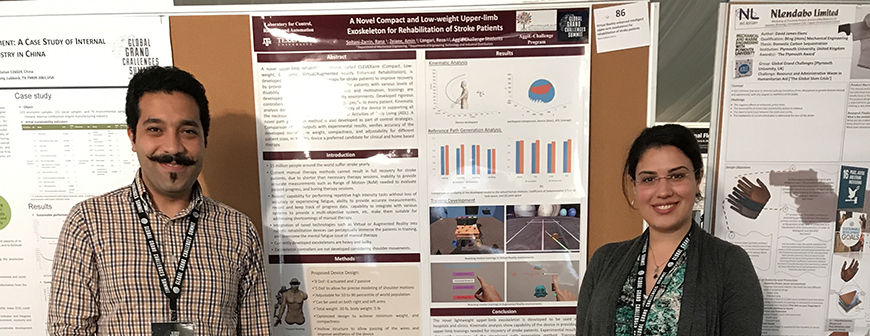
Two graduate students working for the Department of Engineering Technology and Industrial Distribution recently won the Excellence in Societal/Technical Impact Award at the 2017 Global Grand Challenges Summit (GGCS) in Washington, D.C. The biennial GGCS, is jointly organized by the U.S. National Academy of Engineering, U.K. Royal Academy of Engineering and Chinese Academy of Engineering.

Rana Soltani-Zarrin and Amin Zeiaee, mechanical engineering doctoral students in the Texas A&M University College of Engineering, presented their research poster at the competition, titled “Virtual reality enhanced intelligent upper-limb exoskeleton for rehabilitation of stroke patients.”
The project aims to help stroke patients relearn motor skills they have lost and regain abilities to perform activities of daily living using an intelligent upper limb robotic device.
The device provides assistance and resistance to patients with various levels of disability to increase strength, flexibility and range of motion of their upper-limb, making it a more effective recovery as an alternative to labor-intensive, limited-time manual therapy. Furthermore, training developed in augmented and virtual reality environments can be used as additional features to provide more entraining and motivating therapy for patients.
Originally a proposal from the Laboratory for Control, Robotics and Automation, directed by Dr. Reza Langari, department head in the engineering technology and industrial distribution department, Soltani and Zeiaee began their research to bring the idea into reality in 2015.
Using a combination of electrical, mechanical and mechatronic engineering, Soltani and Zeiaee have been developing a prototype for clinical settings that will hopefully one day be provided as a home-based exoskeleton for rehabilitation.
Only 37 graduate and 49 in undergraduate level students were selected for this competition among more than 150 submitted abstracts from United States, United Kingdom and China. There were three awards for each category (graduate and undergraduate). The winners were selected for societal/technical impact of the research, the novelty of research or the poster design. Judges were professionals from academia, government and industry.
Soltani and Zeiaee’s research was selected as the winner of the societal/technical impact award. Each winning team was awarded a certificate and a cash prize of $2,000, by the National Academy of Engineering. Among the six winners, one was from China, one from the United Kingdom and four winners from the United States.